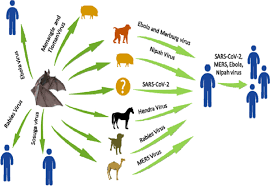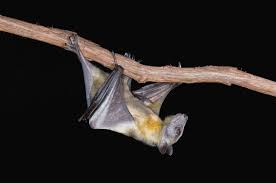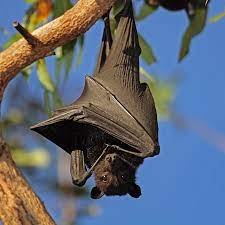Unveiling Bat-Borne Viruses:
Exploring the Risks and Impact on Human Health" encompasses a broad spectrum of virology, wildlife ecology, and public health concerns. Bats, as natural reservoirs for numerous viruses, have drawn significant attention due to their role in transmitting infections to humans and other animals.

Bats as Viral Reservoirs:
Diverse Viral Species: Bats harbor a wide array of viruses owing to their unique immune systems. These viruses include coronaviruses, filoviruses, lyssaviruses, and more.
Transmission Dynamics: Understanding the mechanisms of viral transmission from bats to other species is critical. Direct contact, consumption of contaminated food, or exposure to bat habitats present potential pathways for virus spillover.

Bat-Borne Viruses and Human Health:
Emerging Diseases: Several outbreaks have been linked to bat-borne viruses, notably SARS-CoV, MERS-CoV, and the COVID-19 pandemic caused by SARS-CoV-2. These outbreaks underscore the impact of bat-borne viruses on global health.
Zoonotic Potential: The ability of these viruses to cross species barriers and infect humans highlights the zoonotic threat posed by bat-borne viruses and the need for proactive surveillance.

Preventive Measures and Public Health Implications:
Community Awareness: Educating communities about the risks associated with bat interactions and promoting measures to minimize exposure are crucial in preventing infections.
Biosecurity Measures: Implementing protective measures when handling bats, conducting research in bat-inhabited areas, or working in caves or mines can mitigate transmission risks.
Research and Collaborative Efforts:
Surveillance and Monitoring: Continuous surveillance of bat populations and their viral diversity is essential for early detection, understanding transmission dynamics, and assessing potential threats to human health.
One Health Approach: Collaborative efforts across disciplines, including virology, ecology, veterinary medicine, and public health, are vital for a comprehensive understanding of bat-borne viruses and their impact on human and animal health.
Conclusion:
Addressing the risks associated with bat-borne viruses necessitates a multidisciplinary approach. Research, surveillance, community engagement, and international collaboration are pivotal in managing the potential threats posed by bat-related viruses and mitigating their impact on global public health. Understanding the ecology of bats, their viruses, and the dynamics of spillover events is crucial for preventing future outbreaks and safeguarding human health.
Bat's flu" generally refers to viruses originating from bats that have the potential to cause diseases in humans and other animals. Bats are reservoirs for various viruses due to their unique immune systems that allow them to host and transmit viruses without experiencing severe illness themselves. Some of these viruses can spill over from bats to other species, including humans, leading to diseases that pose significant health concerns.
Zoonotic Viruses Associated with Bats:
Coronaviruses: Notably, viruses like SARS-CoV, MERS-CoV, and SARS-CoV-2 (responsible for COVID-19) are believed to have originated from bats. These viruses underwent genetic mutations or recombination events, allowing them to infect humans and cause severe respiratory illnesses.
Filoviruses: Ebola virus disease, a severe and often fatal illness in humans, is linked to bats as potential reservoirs. While other animals may serve as intermediaries, bats play a crucial role in the virus's natural life cycle.
Lyssaviruses: Bats are natural hosts for various lyssaviruses, including the rabies virus. Although transmission to humans is relatively rare, bat-related rabies cases occur, emphasizing the importance of preventive measures.
Bat-Borne Virus Transmission:
Direct Contact: Transmission can occur through direct contact with bat secretions (like saliva, urine, or feces) or being bitten or scratched by infected bats.
Indirect Contact: Consumption of food contaminated with bat excreta or saliva, or exposure to environments with bat colonies, can also pose a risk of infection.
Preventive Measures:
Public Health Awareness: Educating communities about the risks associated with direct contact or consumption of bats and their excreta is crucial in preventing infections.
Protective Measures: Using personal protective equipment (PPE) like gloves, masks, and proper clothing while handling bats or in areas with bat populations can mitigate transmission risks.
Research and Surveillance:
Virus Detection and Monitoring: Continuous surveillance and research into bat-borne viruses are essential for early detection, understanding transmission pathways, and preventing potential outbreaks.
One Health Approach: Collaborative efforts involving veterinarians, ecologists, virologists, and public health officials are necessary to address the complex interactions between bats, viruses, and human health.
Conclusion:
Understanding and mitigating the risks associated with bat-borne viruses require multifaceted approaches. While bats play a crucial role in ecosystems and provide valuable ecological services, awareness, preventive measures, and ongoing research are vital for minimizing the potential transmission of bat-related viruses to humans and other animals. Integrating public health strategies, surveillance, and a One Health approach can aid in managing the risks associated with bat-borne viruses and their potential impact on human health.
The revelation of bat influenza, starting in minimal yellow-carried bats in Guatemala, raises worries about its expected effect on human wellbeing. While distinguished in different bat species in Focal and South America, studies recommend critical transformations are important for these infections to effectively taint people.
Primer CDC research shows bat influenza battles to develop inside human cells, connoting the requirement for significant changes to proficiently taint people. In any case, hereditary similarity with human seasonal infections flashes worries about their expected development and capacity to contaminate people.
Variation could happen through reassortment, trading hereditary material among seasonal infections inside a host cell. An animal that is both susceptible to the human flu virus and the bat flu is required in this process. Despite the fact that studies indicate a low likelihood of producing highly infectious strains, it is essential to monitor continuously.
While current bat influenza strains seem improbable to straightforwardly undermine people, understanding them supports getting a handle on seasonal infection development and dangers. Hereditary variety among these infections mirrors their broad development in bat populaces over hundreds of years.
Bat flu is distinguished from other strains by distinct surface proteins, which have been designated as new subtypes. In any case, understanding how these proteins cooperate with have cells contrasted with human seasonal infections stays hazy.
The revelation included catching bats, broad cleaning, and genomic sequencing through joint effort among CDC and Universidad del Valle. This emphasizes ongoing monitoring for potential animal-based threats.
Past prompt worries,
bat influenza gives bits of knowledge into seasonal infection advancement and cross-species transmission components. Stressing the job of persistent examination and reconnaissance, this disclosure comprehends and oversee arising irresistible illnesses.



You must be logged in to post a comment.